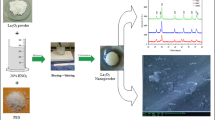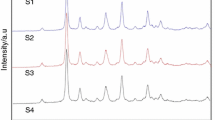Abstract
Nanosized GdVO4 powders were synthesized via a sol–gel method using different carboxylic acids as chelating agent, followed by calcination at 600 °C for 3 h. The effect of different carboxylic acids such as citric acid, malic acid, and tartaric acid on the characteristics of the nanosized GdVO4 powders was investigated. The GdVO4 powder was also synthesized without carboxylic acid for comparison. The thermal decomposition process of the carboxylate precursors was investigated by thermogravimetric differential thermal analysis (TG-DTA). X-ray diffraction (XRD), Fourier transform infrared spectroscopy (FTIR), field emission scanning electron microscope (FESEM), transmission electron microscope (TEM), and surface area measurement data were used to confirm the formation of nanocrystalline GdVO4 powders. It is found that the synthesis using the carboxylic acid with higher heat of combustion results in the powder with larger crystallite size. The difference in the steric effect of the acids used, which was evaluated by a computational method, also affects the degree of agglomeration of the synthesized powders.






Similar content being viewed by others
References
Li X, Yu M, Hou Z, Li G, Ma P, Wang W, Cheng Z, Lin J. One-dimensional GdVO4:Ln3+ (Ln = Eu, Dy, Sm) nanofibers: electrospinning preparation and luminescence properties. J Solid State Chem. 2011;184(1):141.
Li G, Wang Z, Yu M, Quan Z, Lin J. Fabrication and optical properties of core–shell structured spherical SiO2@GdVO4:Eu3+ phosphors via sol–gel process. J Solid State Chem. 2006;179(8):2698.
Fang Z, Hong Q, Zhou Z, Dai S, Weng W, Wan H. Oxidative dehydrogenation of propane over a series of low-temperature rare earth orthovanadate catalysts prepared by nitrate method. Catal Lett. 1999;61(1–2):39.
He Y, Wu Y, Sheng T, Wu X. Photodegradation of acetone over V–Gd–O composite catalysts under visible light. J Hazard Mater. 2010;180(1):675.
Selvan RK, Gedanken A, Anikumar P, Manikandan G, Karunakaran C. Synthesis and characterization of rare earth orthovanadate (RVO4; R = La, Ce, Nd, Sm, Eu & Gd) nanorods/nanocrystals/nanospindles by a facial sonochemical method and their catalytic properties. J Clust Sci. 2009;20(2):291.
Chumha N, Kittiwachana S, Thongtem T, Thongtem S, Kaowphong S. Synthesis and characterization of GdVO4 nanoparticles by a malic acid-assisted sol–gel method. Mater Lett. 2014;136:18.
Lü X, Xie J, Shu H, Liu J, Yin C, Lin J. Microwave-assisted synthesis of nanocrystalline YFeO3 and study of its photoactivity. Mater Sci Eng B. 2007;138(3):289.
Zhang D, Du X, Shi L, Gao R. Shaped-controlled synthesis and catalytic application of ceria nanomaterials. Dalton Trans. 2012;41(48):14455.
Huang L, Shi L, Zhao X, Xu J, Li H, Zhang J, Zhang D. Hydrothermal growth and characterization of length tunable porous iron vanadate one-dimensional nanostructures. CrystEngComm. 2014;16(23):5128.
Zhang H, Shu J, Wei X, Wang K, Chen J. Cerium vanadate nanoparticles as a new anode material for lithium ion batteries. RSC Adv. 2013;3(20):7403.
Huang L, Zhao X, Zhang L, Shi L, Zhang J, Zhang D. Large-scale growth of hierarchical transition-metal vanadate nanosheets on metal meshes as monolith catalysts for De-NO x reaction. Nanoscale. 2015;7(6):2743.
Liu Y, Liu C, Zhang Z. Effects of carboxylic acids on the microstructure and performance of titania nanocrystals. Chem Eng J. 2008;138(1–3):596.
Shui M, Zheng W, Shu J, Wang Q, Gao S, Xu D, Chen L, Feng L, Ren Y. Synthesis and electrochemical performance of Li1+x V3O8 as cathode material prepared by citric acid and tartaric acid assisted sol–gel processes. Curr Appl Phys. 2013;13(3):517.
Wang D, Cao L, Huang J, Wu J. Effects of different chelating agents on the composition, morphology and electrochemical properties of LiV3O8 crystallites synthesized via sol–gel method. Ceram Int. 2013;39(4):3759.
Yang L, Li L, Zhao M, Li G. Size-induced variations in bulk/surface structures and their impact on photoluminescence properties of GdVO4:Eu3+ nanoparticles. Phys Chem Chem Phys. 2012;14(28):9956.
Thongtem T, Kaowphong S, Thongtem S. Malic acid complex method for preparation of LiNiVO4 nano-crystallites. J Mater Sci. 2007;42(11):3923.
Lin-Vien D. The handbook of infrared and Raman characteristic frequencies of organic molecules. 1st ed. New York: Academic Press; 1991. 139.
Byrappa K, Chandrashekar CK, Basavalingu B, LokanathaRai KM, Ananda S, Yoshimura M. Growth, morphology and mechanism of rare earth vanadate crystals under mild hydrothermal conditions. J Cryst Growth. 2007;306(1):94.
Fey GTK, Shiu RF, Subramanian V, Chen CL. The effect of varying the acid to metal ion ratio R on the structural, thermal, and electrochemical properties of sol–gel derived lithium nickel cobalt oxides. Solid State Ion. 2002;148(3–4):291.
Suryanarayana C, Norton MG. X-Ray Diffraction: a Practical Approach. New York: Plenum Press; 1998. 207.
Chumha N, Kittiwachana S, Thongtem T, Thongtem S, Kaowphong S. Synthesis and characterization of GdVO4 nanostructures by a tartaric acid-assisted sol–gel method. Ceram Int. 2014;40(10):16337.
Domalski ES. Selected values of heat of combustion and heats of formation of organic compounds containing the elements C, H, N, O, P, and S. J Phys Chem Ref Data. 1972;1(2):221.
Chandradass J, Kim MH, Bae D. Influence of citric acid to aluminium nitrate molar ratio on the combustion synthesis of alumina-zirconia nanopowder. J Alloys Compd. 2009;470(1–2):L9.
Ryba-Romanowski W, Lisiecki R, Jelinková H, Šulc J. Thulium-doped vanadate crystals: growth, spectroscopy and laser performance. Prog Quantum Electron. 2011;35(5):109.
William DB, Carter CB. Transmission Electron Microscopy: a Textbook for Materials Science. New York: Plenum Press; 1996. 150.
Acknowledgments
This work was financially supported by the Chiang Mai University (CMU) Junior Research Fellowship Program and the National Research University (NRU) Project from Thailand’s Office of the Higher Education Commission.
Author information
Authors and Affiliations
Corresponding author
Rights and permissions
About this article
Cite this article
Kaowphong, S., Chumha, N., Nimmanpipug, P. et al. Nanosized GdVO4 powders synthesized by sol–gel method using different carboxylic acids. Rare Met. 37, 561–567 (2018). https://doi.org/10.1007/s12598-015-0681-4
Received:
Revised:
Accepted:
Published:
Issue Date:
DOI: https://doi.org/10.1007/s12598-015-0681-4




